Process and Diagnostic Tools - Assignment
VerifiedAdded on 2021/01/04
|12
|3510
|34
AI Summary
Contribute Materials
Your contribution can guide someone’s learning journey. Share your
documents today.
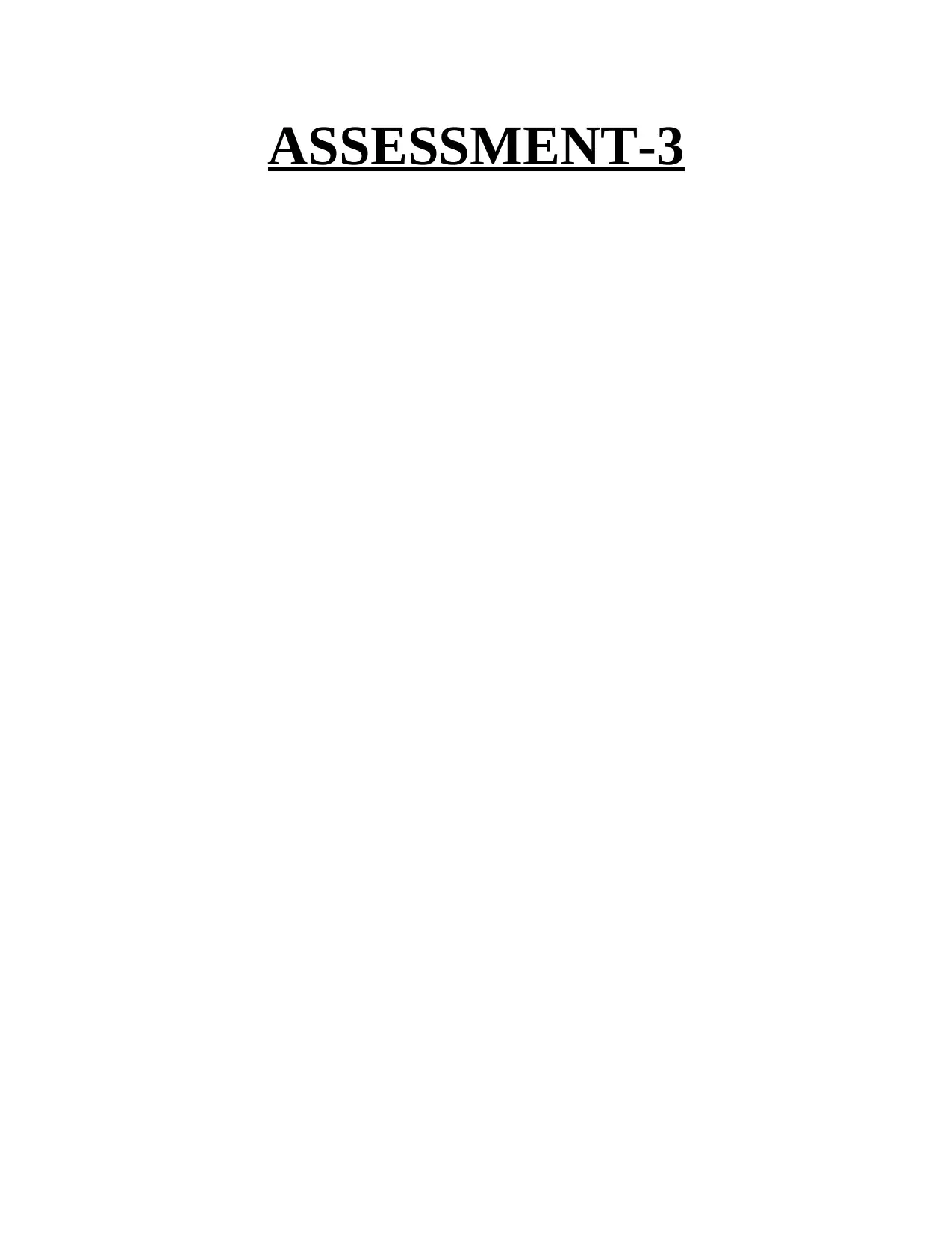
ASSESSMENT-3
Secure Best Marks with AI Grader
Need help grading? Try our AI Grader for instant feedback on your assignments.
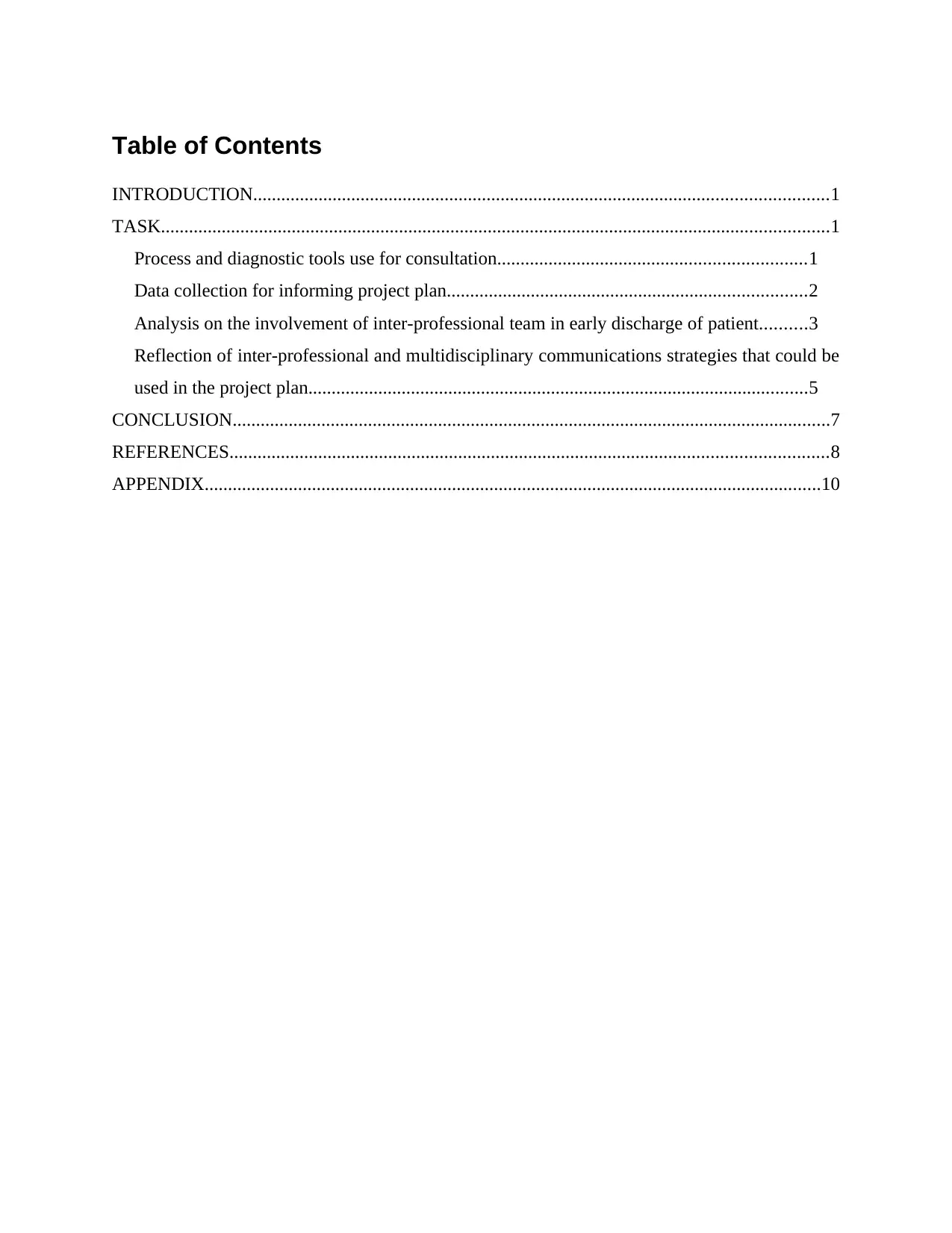
Table of Contents
INTRODUCTION...........................................................................................................................1
TASK...............................................................................................................................................1
Process and diagnostic tools use for consultation..................................................................1
Data collection for informing project plan.............................................................................2
Analysis on the involvement of inter-professional team in early discharge of patient..........3
Reflection of inter-professional and multidisciplinary communications strategies that could be
used in the project plan...........................................................................................................5
CONCLUSION................................................................................................................................7
REFERENCES................................................................................................................................8
APPENDIX....................................................................................................................................10
INTRODUCTION...........................................................................................................................1
TASK...............................................................................................................................................1
Process and diagnostic tools use for consultation..................................................................1
Data collection for informing project plan.............................................................................2
Analysis on the involvement of inter-professional team in early discharge of patient..........3
Reflection of inter-professional and multidisciplinary communications strategies that could be
used in the project plan...........................................................................................................5
CONCLUSION................................................................................................................................7
REFERENCES................................................................................................................................8
APPENDIX....................................................................................................................................10
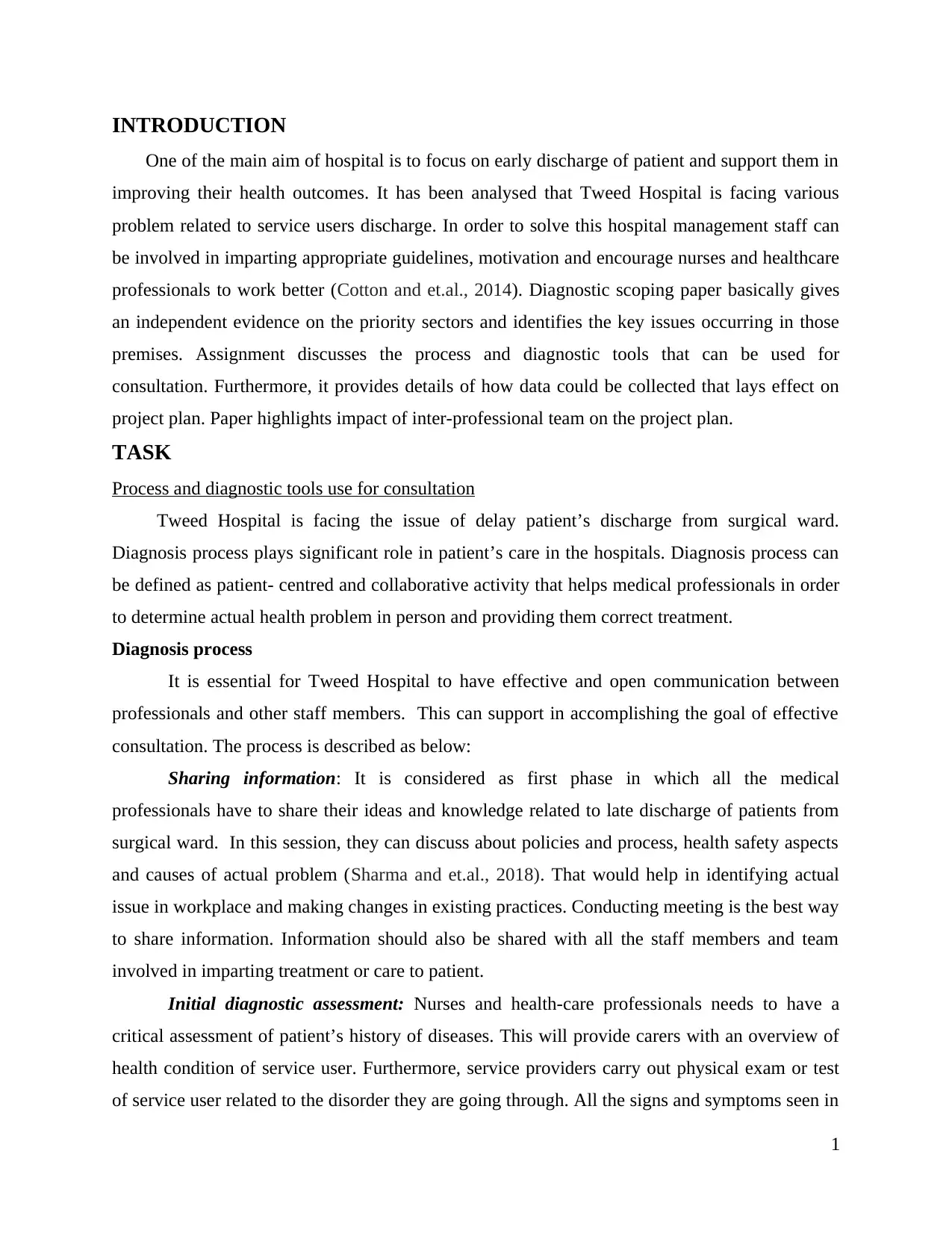
INTRODUCTION
One of the main aim of hospital is to focus on early discharge of patient and support them in
improving their health outcomes. It has been analysed that Tweed Hospital is facing various
problem related to service users discharge. In order to solve this hospital management staff can
be involved in imparting appropriate guidelines, motivation and encourage nurses and healthcare
professionals to work better (Cotton and et.al., 2014). Diagnostic scoping paper basically gives
an independent evidence on the priority sectors and identifies the key issues occurring in those
premises. Assignment discusses the process and diagnostic tools that can be used for
consultation. Furthermore, it provides details of how data could be collected that lays effect on
project plan. Paper highlights impact of inter-professional team on the project plan.
TASK
Process and diagnostic tools use for consultation
Tweed Hospital is facing the issue of delay patient’s discharge from surgical ward.
Diagnosis process plays significant role in patient’s care in the hospitals. Diagnosis process can
be defined as patient- centred and collaborative activity that helps medical professionals in order
to determine actual health problem in person and providing them correct treatment.
Diagnosis process
It is essential for Tweed Hospital to have effective and open communication between
professionals and other staff members. This can support in accomplishing the goal of effective
consultation. The process is described as below:
Sharing information: It is considered as first phase in which all the medical
professionals have to share their ideas and knowledge related to late discharge of patients from
surgical ward. In this session, they can discuss about policies and process, health safety aspects
and causes of actual problem (Sharma and et.al., 2018). That would help in identifying actual
issue in workplace and making changes in existing practices. Conducting meeting is the best way
to share information. Information should also be shared with all the staff members and team
involved in imparting treatment or care to patient.
Initial diagnostic assessment: Nurses and health-care professionals needs to have a
critical assessment of patient’s history of diseases. This will provide carers with an overview of
health condition of service user. Furthermore, service providers carry out physical exam or test
of service user related to the disorder they are going through. All the signs and symptoms seen in
1
One of the main aim of hospital is to focus on early discharge of patient and support them in
improving their health outcomes. It has been analysed that Tweed Hospital is facing various
problem related to service users discharge. In order to solve this hospital management staff can
be involved in imparting appropriate guidelines, motivation and encourage nurses and healthcare
professionals to work better (Cotton and et.al., 2014). Diagnostic scoping paper basically gives
an independent evidence on the priority sectors and identifies the key issues occurring in those
premises. Assignment discusses the process and diagnostic tools that can be used for
consultation. Furthermore, it provides details of how data could be collected that lays effect on
project plan. Paper highlights impact of inter-professional team on the project plan.
TASK
Process and diagnostic tools use for consultation
Tweed Hospital is facing the issue of delay patient’s discharge from surgical ward.
Diagnosis process plays significant role in patient’s care in the hospitals. Diagnosis process can
be defined as patient- centred and collaborative activity that helps medical professionals in order
to determine actual health problem in person and providing them correct treatment.
Diagnosis process
It is essential for Tweed Hospital to have effective and open communication between
professionals and other staff members. This can support in accomplishing the goal of effective
consultation. The process is described as below:
Sharing information: It is considered as first phase in which all the medical
professionals have to share their ideas and knowledge related to late discharge of patients from
surgical ward. In this session, they can discuss about policies and process, health safety aspects
and causes of actual problem (Sharma and et.al., 2018). That would help in identifying actual
issue in workplace and making changes in existing practices. Conducting meeting is the best way
to share information. Information should also be shared with all the staff members and team
involved in imparting treatment or care to patient.
Initial diagnostic assessment: Nurses and health-care professionals needs to have a
critical assessment of patient’s history of diseases. This will provide carers with an overview of
health condition of service user. Furthermore, service providers carry out physical exam or test
of service user related to the disorder they are going through. All the signs and symptoms seen in
1
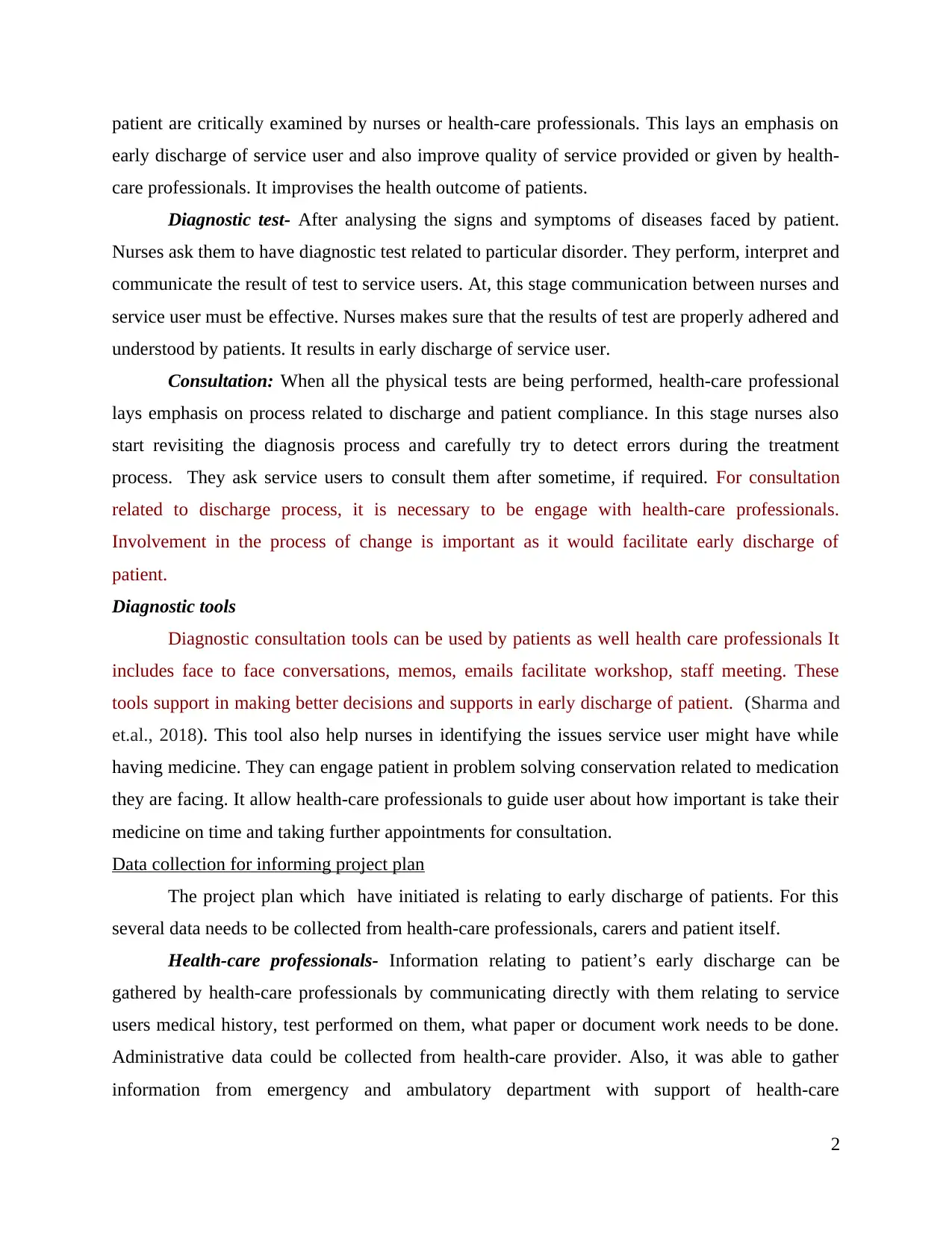
patient are critically examined by nurses or health-care professionals. This lays an emphasis on
early discharge of service user and also improve quality of service provided or given by health-
care professionals. It improvises the health outcome of patients.
Diagnostic test- After analysing the signs and symptoms of diseases faced by patient.
Nurses ask them to have diagnostic test related to particular disorder. They perform, interpret and
communicate the result of test to service users. At, this stage communication between nurses and
service user must be effective. Nurses makes sure that the results of test are properly adhered and
understood by patients. It results in early discharge of service user.
Consultation: When all the physical tests are being performed, health-care professional
lays emphasis on process related to discharge and patient compliance. In this stage nurses also
start revisiting the diagnosis process and carefully try to detect errors during the treatment
process. They ask service users to consult them after sometime, if required. For consultation
related to discharge process, it is necessary to be engage with health-care professionals.
Involvement in the process of change is important as it would facilitate early discharge of
patient.
Diagnostic tools
Diagnostic consultation tools can be used by patients as well health care professionals It
includes face to face conversations, memos, emails facilitate workshop, staff meeting. These
tools support in making better decisions and supports in early discharge of patient. (Sharma and
et.al., 2018). This tool also help nurses in identifying the issues service user might have while
having medicine. They can engage patient in problem solving conservation related to medication
they are facing. It allow health-care professionals to guide user about how important is take their
medicine on time and taking further appointments for consultation.
Data collection for informing project plan
The project plan which have initiated is relating to early discharge of patients. For this
several data needs to be collected from health-care professionals, carers and patient itself.
Health-care professionals- Information relating to patient’s early discharge can be
gathered by health-care professionals by communicating directly with them relating to service
users medical history, test performed on them, what paper or document work needs to be done.
Administrative data could be collected from health-care provider. Also, it was able to gather
information from emergency and ambulatory department with support of health-care
2
early discharge of service user and also improve quality of service provided or given by health-
care professionals. It improvises the health outcome of patients.
Diagnostic test- After analysing the signs and symptoms of diseases faced by patient.
Nurses ask them to have diagnostic test related to particular disorder. They perform, interpret and
communicate the result of test to service users. At, this stage communication between nurses and
service user must be effective. Nurses makes sure that the results of test are properly adhered and
understood by patients. It results in early discharge of service user.
Consultation: When all the physical tests are being performed, health-care professional
lays emphasis on process related to discharge and patient compliance. In this stage nurses also
start revisiting the diagnosis process and carefully try to detect errors during the treatment
process. They ask service users to consult them after sometime, if required. For consultation
related to discharge process, it is necessary to be engage with health-care professionals.
Involvement in the process of change is important as it would facilitate early discharge of
patient.
Diagnostic tools
Diagnostic consultation tools can be used by patients as well health care professionals It
includes face to face conversations, memos, emails facilitate workshop, staff meeting. These
tools support in making better decisions and supports in early discharge of patient. (Sharma and
et.al., 2018). This tool also help nurses in identifying the issues service user might have while
having medicine. They can engage patient in problem solving conservation related to medication
they are facing. It allow health-care professionals to guide user about how important is take their
medicine on time and taking further appointments for consultation.
Data collection for informing project plan
The project plan which have initiated is relating to early discharge of patients. For this
several data needs to be collected from health-care professionals, carers and patient itself.
Health-care professionals- Information relating to patient’s early discharge can be
gathered by health-care professionals by communicating directly with them relating to service
users medical history, test performed on them, what paper or document work needs to be done.
Administrative data could be collected from health-care provider. Also, it was able to gather
information from emergency and ambulatory department with support of health-care
2
Secure Best Marks with AI Grader
Need help grading? Try our AI Grader for instant feedback on your assignments.
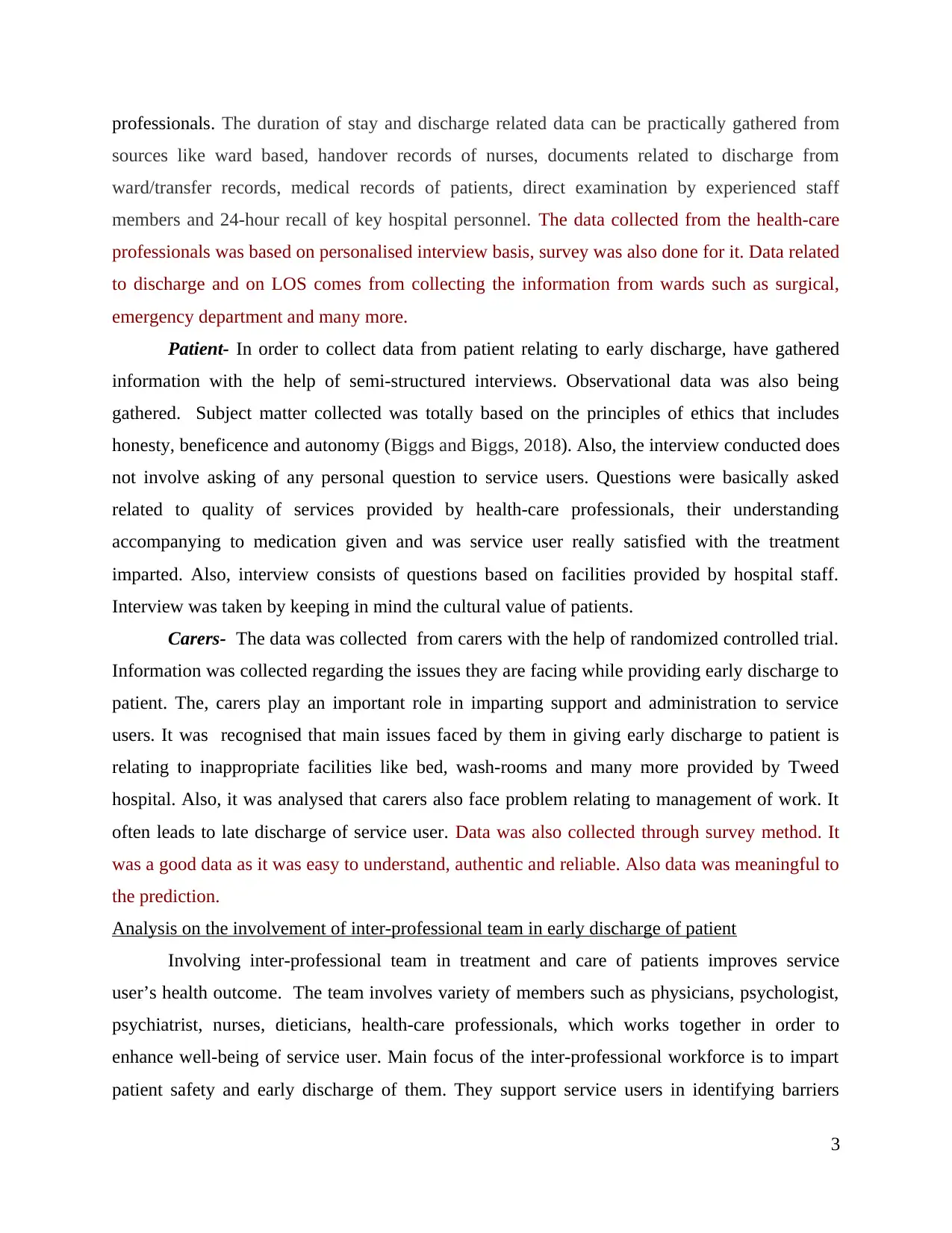
professionals. The duration of stay and discharge related data can be practically gathered from
sources like ward based, handover records of nurses, documents related to discharge from
ward/transfer records, medical records of patients, direct examination by experienced staff
members and 24-hour recall of key hospital personnel. The data collected from the health-care
professionals was based on personalised interview basis, survey was also done for it. Data related
to discharge and on LOS comes from collecting the information from wards such as surgical,
emergency department and many more.
Patient- In order to collect data from patient relating to early discharge, have gathered
information with the help of semi-structured interviews. Observational data was also being
gathered. Subject matter collected was totally based on the principles of ethics that includes
honesty, beneficence and autonomy (Biggs and Biggs, 2018). Also, the interview conducted does
not involve asking of any personal question to service users. Questions were basically asked
related to quality of services provided by health-care professionals, their understanding
accompanying to medication given and was service user really satisfied with the treatment
imparted. Also, interview consists of questions based on facilities provided by hospital staff.
Interview was taken by keeping in mind the cultural value of patients.
Carers- The data was collected from carers with the help of randomized controlled trial.
Information was collected regarding the issues they are facing while providing early discharge to
patient. The, carers play an important role in imparting support and administration to service
users. It was recognised that main issues faced by them in giving early discharge to patient is
relating to inappropriate facilities like bed, wash-rooms and many more provided by Tweed
hospital. Also, it was analysed that carers also face problem relating to management of work. It
often leads to late discharge of service user. Data was also collected through survey method. It
was a good data as it was easy to understand, authentic and reliable. Also data was meaningful to
the prediction.
Analysis on the involvement of inter-professional team in early discharge of patient
Involving inter-professional team in treatment and care of patients improves service
user’s health outcome. The team involves variety of members such as physicians, psychologist,
psychiatrist, nurses, dieticians, health-care professionals, which works together in order to
enhance well-being of service user. Main focus of the inter-professional workforce is to impart
patient safety and early discharge of them. They support service users in identifying barriers
3
sources like ward based, handover records of nurses, documents related to discharge from
ward/transfer records, medical records of patients, direct examination by experienced staff
members and 24-hour recall of key hospital personnel. The data collected from the health-care
professionals was based on personalised interview basis, survey was also done for it. Data related
to discharge and on LOS comes from collecting the information from wards such as surgical,
emergency department and many more.
Patient- In order to collect data from patient relating to early discharge, have gathered
information with the help of semi-structured interviews. Observational data was also being
gathered. Subject matter collected was totally based on the principles of ethics that includes
honesty, beneficence and autonomy (Biggs and Biggs, 2018). Also, the interview conducted does
not involve asking of any personal question to service users. Questions were basically asked
related to quality of services provided by health-care professionals, their understanding
accompanying to medication given and was service user really satisfied with the treatment
imparted. Also, interview consists of questions based on facilities provided by hospital staff.
Interview was taken by keeping in mind the cultural value of patients.
Carers- The data was collected from carers with the help of randomized controlled trial.
Information was collected regarding the issues they are facing while providing early discharge to
patient. The, carers play an important role in imparting support and administration to service
users. It was recognised that main issues faced by them in giving early discharge to patient is
relating to inappropriate facilities like bed, wash-rooms and many more provided by Tweed
hospital. Also, it was analysed that carers also face problem relating to management of work. It
often leads to late discharge of service user. Data was also collected through survey method. It
was a good data as it was easy to understand, authentic and reliable. Also data was meaningful to
the prediction.
Analysis on the involvement of inter-professional team in early discharge of patient
Involving inter-professional team in treatment and care of patients improves service
user’s health outcome. The team involves variety of members such as physicians, psychologist,
psychiatrist, nurses, dieticians, health-care professionals, which works together in order to
enhance well-being of service user. Main focus of the inter-professional workforce is to impart
patient safety and early discharge of them. They support service users in identifying barriers
3
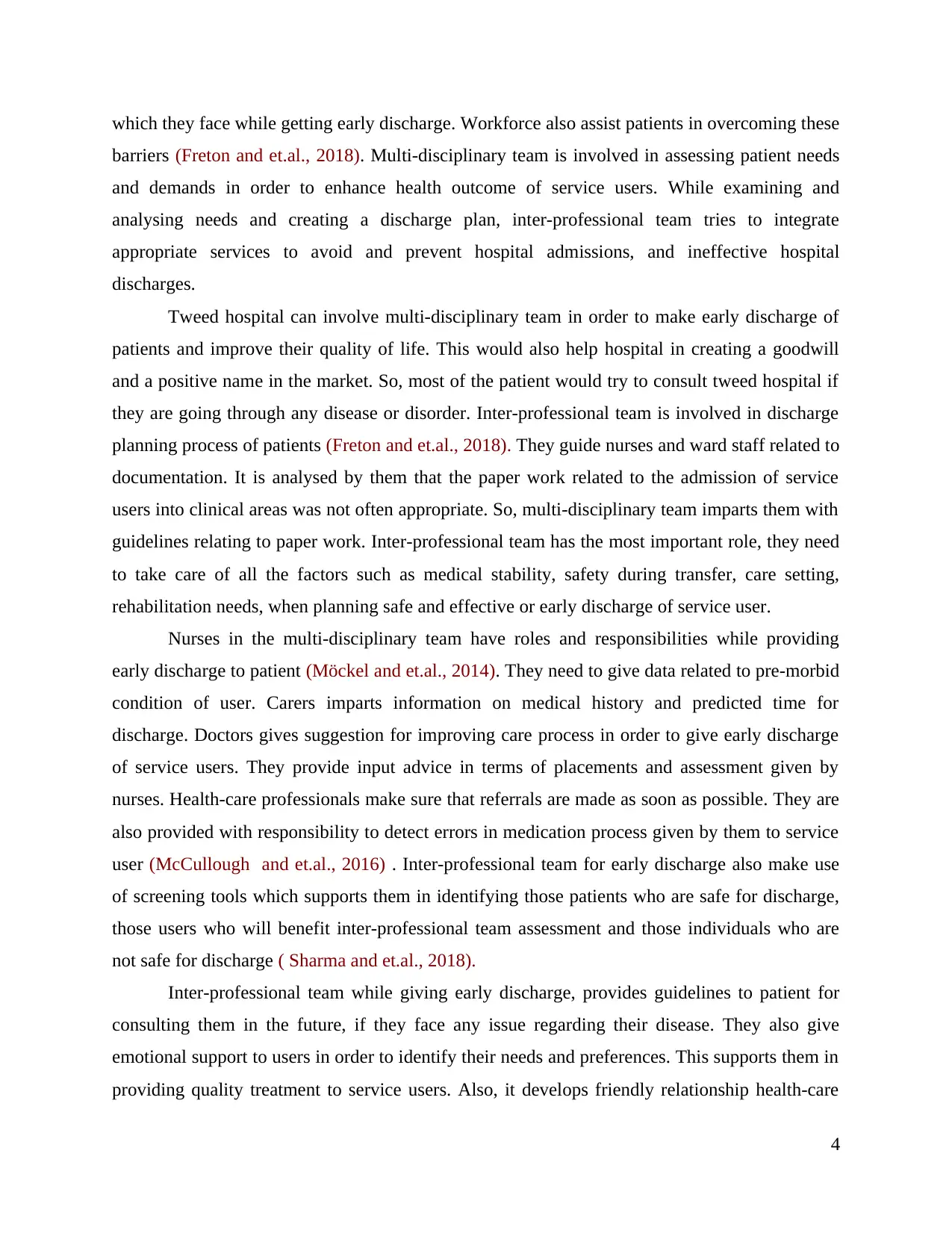
which they face while getting early discharge. Workforce also assist patients in overcoming these
barriers (Freton and et.al., 2018). Multi-disciplinary team is involved in assessing patient needs
and demands in order to enhance health outcome of service users. While examining and
analysing needs and creating a discharge plan, inter-professional team tries to integrate
appropriate services to avoid and prevent hospital admissions, and ineffective hospital
discharges.
Tweed hospital can involve multi-disciplinary team in order to make early discharge of
patients and improve their quality of life. This would also help hospital in creating a goodwill
and a positive name in the market. So, most of the patient would try to consult tweed hospital if
they are going through any disease or disorder. Inter-professional team is involved in discharge
planning process of patients (Freton and et.al., 2018). They guide nurses and ward staff related to
documentation. It is analysed by them that the paper work related to the admission of service
users into clinical areas was not often appropriate. So, multi-disciplinary team imparts them with
guidelines relating to paper work. Inter-professional team has the most important role, they need
to take care of all the factors such as medical stability, safety during transfer, care setting,
rehabilitation needs, when planning safe and effective or early discharge of service user.
Nurses in the multi-disciplinary team have roles and responsibilities while providing
early discharge to patient (Möckel and et.al., 2014). They need to give data related to pre-morbid
condition of user. Carers imparts information on medical history and predicted time for
discharge. Doctors gives suggestion for improving care process in order to give early discharge
of service users. They provide input advice in terms of placements and assessment given by
nurses. Health-care professionals make sure that referrals are made as soon as possible. They are
also provided with responsibility to detect errors in medication process given by them to service
user (McCullough and et.al., 2016) . Inter-professional team for early discharge also make use
of screening tools which supports them in identifying those patients who are safe for discharge,
those users who will benefit inter-professional team assessment and those individuals who are
not safe for discharge ( Sharma and et.al., 2018).
Inter-professional team while giving early discharge, provides guidelines to patient for
consulting them in the future, if they face any issue regarding their disease. They also give
emotional support to users in order to identify their needs and preferences. This supports them in
providing quality treatment to service users. Also, it develops friendly relationship health-care
4
barriers (Freton and et.al., 2018). Multi-disciplinary team is involved in assessing patient needs
and demands in order to enhance health outcome of service users. While examining and
analysing needs and creating a discharge plan, inter-professional team tries to integrate
appropriate services to avoid and prevent hospital admissions, and ineffective hospital
discharges.
Tweed hospital can involve multi-disciplinary team in order to make early discharge of
patients and improve their quality of life. This would also help hospital in creating a goodwill
and a positive name in the market. So, most of the patient would try to consult tweed hospital if
they are going through any disease or disorder. Inter-professional team is involved in discharge
planning process of patients (Freton and et.al., 2018). They guide nurses and ward staff related to
documentation. It is analysed by them that the paper work related to the admission of service
users into clinical areas was not often appropriate. So, multi-disciplinary team imparts them with
guidelines relating to paper work. Inter-professional team has the most important role, they need
to take care of all the factors such as medical stability, safety during transfer, care setting,
rehabilitation needs, when planning safe and effective or early discharge of service user.
Nurses in the multi-disciplinary team have roles and responsibilities while providing
early discharge to patient (Möckel and et.al., 2014). They need to give data related to pre-morbid
condition of user. Carers imparts information on medical history and predicted time for
discharge. Doctors gives suggestion for improving care process in order to give early discharge
of service users. They provide input advice in terms of placements and assessment given by
nurses. Health-care professionals make sure that referrals are made as soon as possible. They are
also provided with responsibility to detect errors in medication process given by them to service
user (McCullough and et.al., 2016) . Inter-professional team for early discharge also make use
of screening tools which supports them in identifying those patients who are safe for discharge,
those users who will benefit inter-professional team assessment and those individuals who are
not safe for discharge ( Sharma and et.al., 2018).
Inter-professional team while giving early discharge, provides guidelines to patient for
consulting them in the future, if they face any issue regarding their disease. They also give
emotional support to users in order to identify their needs and preferences. This supports them in
providing quality treatment to service users. Also, it develops friendly relationship health-care
4
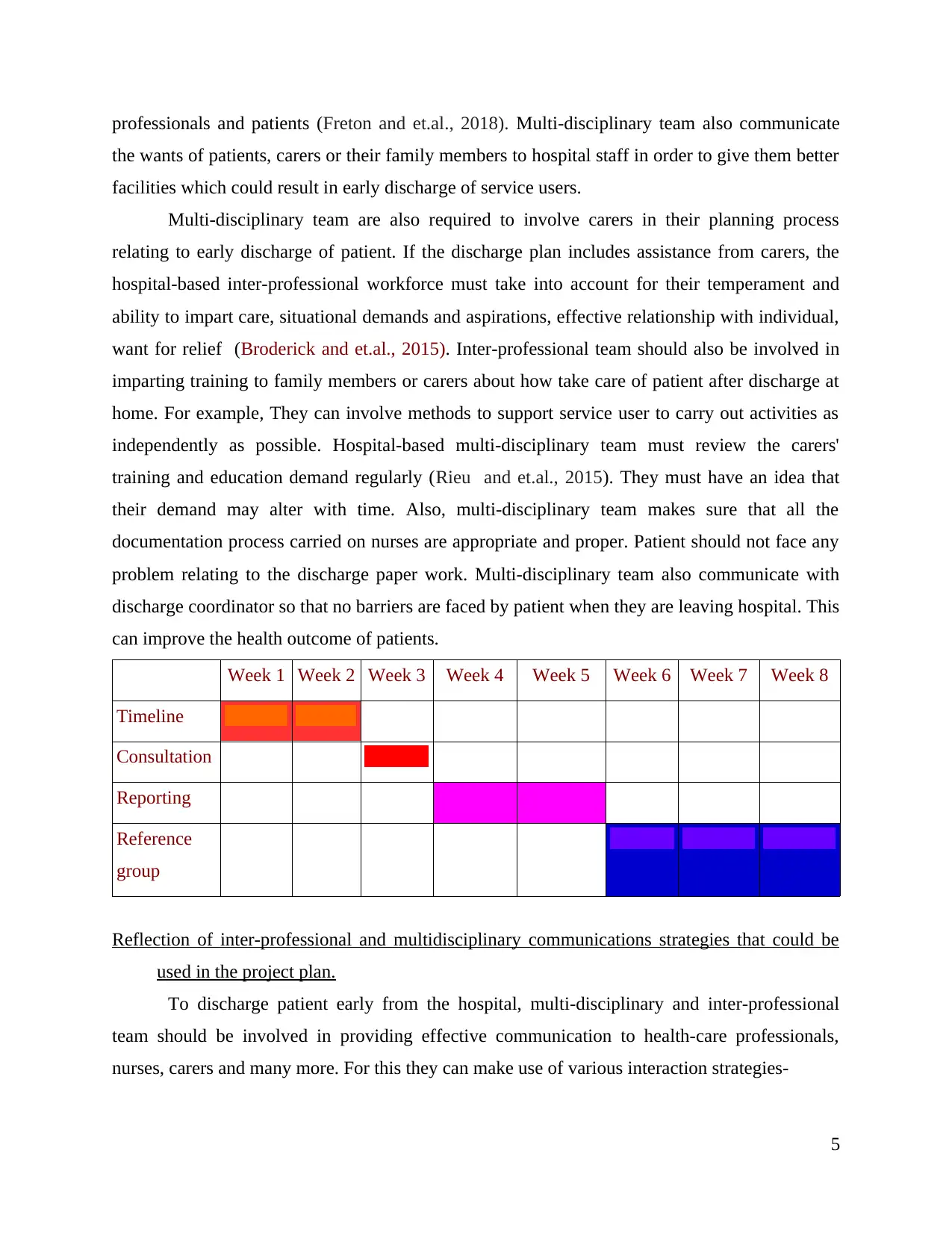
professionals and patients (Freton and et.al., 2018). Multi-disciplinary team also communicate
the wants of patients, carers or their family members to hospital staff in order to give them better
facilities which could result in early discharge of service users.
Multi-disciplinary team are also required to involve carers in their planning process
relating to early discharge of patient. If the discharge plan includes assistance from carers, the
hospital-based inter-professional workforce must take into account for their temperament and
ability to impart care, situational demands and aspirations, effective relationship with individual,
want for relief (Broderick and et.al., 2015). Inter-professional team should also be involved in
imparting training to family members or carers about how take care of patient after discharge at
home. For example, They can involve methods to support service user to carry out activities as
independently as possible. Hospital-based multi-disciplinary team must review the carers'
training and education demand regularly (Rieu and et.al., 2015). They must have an idea that
their demand may alter with time. Also, multi-disciplinary team makes sure that all the
documentation process carried on nurses are appropriate and proper. Patient should not face any
problem relating to the discharge paper work. Multi-disciplinary team also communicate with
discharge coordinator so that no barriers are faced by patient when they are leaving hospital. This
can improve the health outcome of patients.
Week 1 Week 2 Week 3 Week 4 Week 5 Week 6 Week 7 Week 8
Timeline
Consultation
Reporting
Reference
group
Reflection of inter-professional and multidisciplinary communications strategies that could be
used in the project plan.
To discharge patient early from the hospital, multi-disciplinary and inter-professional
team should be involved in providing effective communication to health-care professionals,
nurses, carers and many more. For this they can make use of various interaction strategies-
5
the wants of patients, carers or their family members to hospital staff in order to give them better
facilities which could result in early discharge of service users.
Multi-disciplinary team are also required to involve carers in their planning process
relating to early discharge of patient. If the discharge plan includes assistance from carers, the
hospital-based inter-professional workforce must take into account for their temperament and
ability to impart care, situational demands and aspirations, effective relationship with individual,
want for relief (Broderick and et.al., 2015). Inter-professional team should also be involved in
imparting training to family members or carers about how take care of patient after discharge at
home. For example, They can involve methods to support service user to carry out activities as
independently as possible. Hospital-based multi-disciplinary team must review the carers'
training and education demand regularly (Rieu and et.al., 2015). They must have an idea that
their demand may alter with time. Also, multi-disciplinary team makes sure that all the
documentation process carried on nurses are appropriate and proper. Patient should not face any
problem relating to the discharge paper work. Multi-disciplinary team also communicate with
discharge coordinator so that no barriers are faced by patient when they are leaving hospital. This
can improve the health outcome of patients.
Week 1 Week 2 Week 3 Week 4 Week 5 Week 6 Week 7 Week 8
Timeline
Consultation
Reporting
Reference
group
Reflection of inter-professional and multidisciplinary communications strategies that could be
used in the project plan.
To discharge patient early from the hospital, multi-disciplinary and inter-professional
team should be involved in providing effective communication to health-care professionals,
nurses, carers and many more. For this they can make use of various interaction strategies-
5
Paraphrase This Document
Need a fresh take? Get an instant paraphrase of this document with our AI Paraphraser
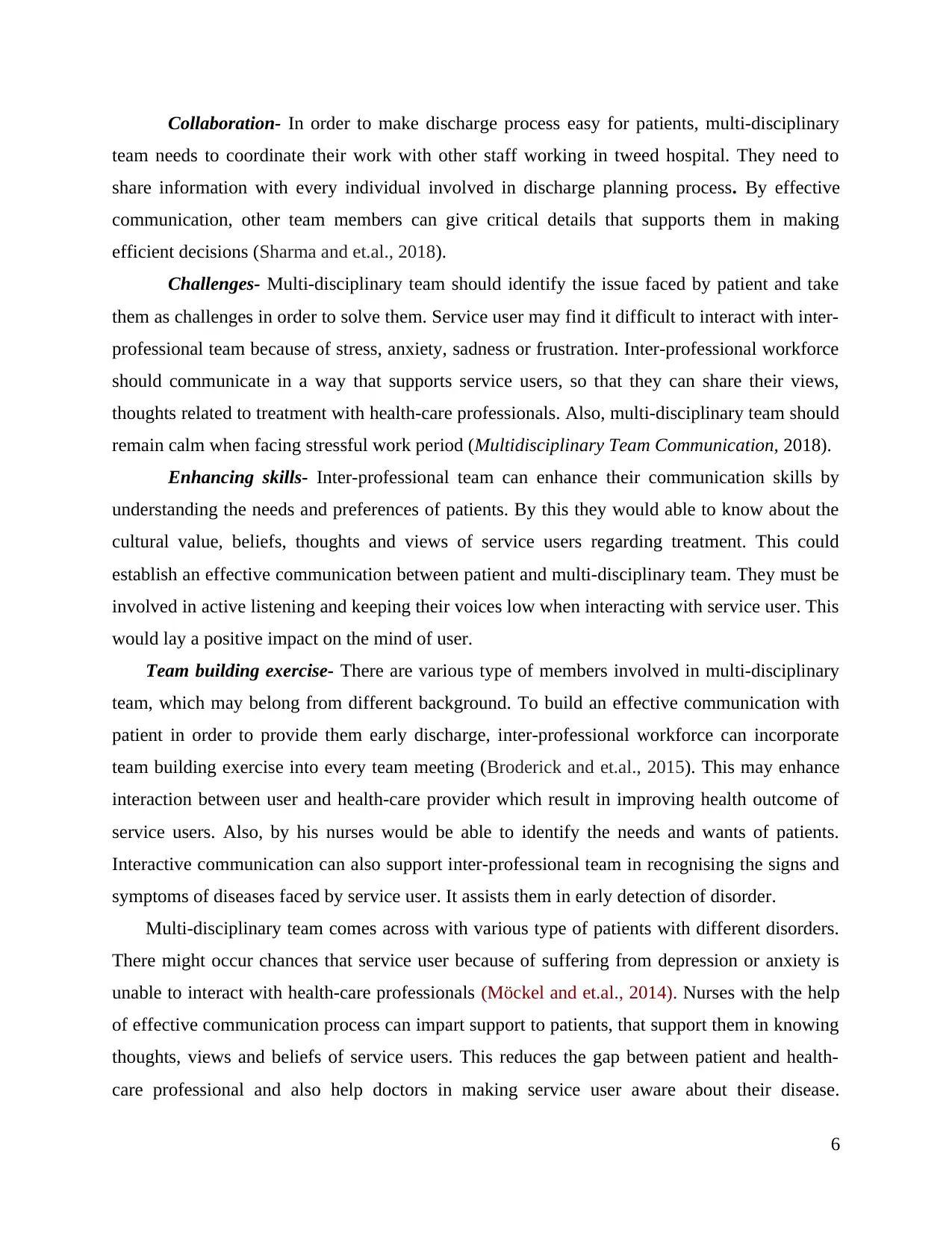
Collaboration- In order to make discharge process easy for patients, multi-disciplinary
team needs to coordinate their work with other staff working in tweed hospital. They need to
share information with every individual involved in discharge planning process. By effective
communication, other team members can give critical details that supports them in making
efficient decisions (Sharma and et.al., 2018).
Challenges- Multi-disciplinary team should identify the issue faced by patient and take
them as challenges in order to solve them. Service user may find it difficult to interact with inter-
professional team because of stress, anxiety, sadness or frustration. Inter-professional workforce
should communicate in a way that supports service users, so that they can share their views,
thoughts related to treatment with health-care professionals. Also, multi-disciplinary team should
remain calm when facing stressful work period (Multidisciplinary Team Communication, 2018).
Enhancing skills- Inter-professional team can enhance their communication skills by
understanding the needs and preferences of patients. By this they would able to know about the
cultural value, beliefs, thoughts and views of service users regarding treatment. This could
establish an effective communication between patient and multi-disciplinary team. They must be
involved in active listening and keeping their voices low when interacting with service user. This
would lay a positive impact on the mind of user.
Team building exercise- There are various type of members involved in multi-disciplinary
team, which may belong from different background. To build an effective communication with
patient in order to provide them early discharge, inter-professional workforce can incorporate
team building exercise into every team meeting (Broderick and et.al., 2015). This may enhance
interaction between user and health-care provider which result in improving health outcome of
service users. Also, by his nurses would be able to identify the needs and wants of patients.
Interactive communication can also support inter-professional team in recognising the signs and
symptoms of diseases faced by service user. It assists them in early detection of disorder.
Multi-disciplinary team comes across with various type of patients with different disorders.
There might occur chances that service user because of suffering from depression or anxiety is
unable to interact with health-care professionals (Möckel and et.al., 2014). Nurses with the help
of effective communication process can impart support to patients, that support them in knowing
thoughts, views and beliefs of service users. This reduces the gap between patient and health-
care professional and also help doctors in making service user aware about their disease.
6
team needs to coordinate their work with other staff working in tweed hospital. They need to
share information with every individual involved in discharge planning process. By effective
communication, other team members can give critical details that supports them in making
efficient decisions (Sharma and et.al., 2018).
Challenges- Multi-disciplinary team should identify the issue faced by patient and take
them as challenges in order to solve them. Service user may find it difficult to interact with inter-
professional team because of stress, anxiety, sadness or frustration. Inter-professional workforce
should communicate in a way that supports service users, so that they can share their views,
thoughts related to treatment with health-care professionals. Also, multi-disciplinary team should
remain calm when facing stressful work period (Multidisciplinary Team Communication, 2018).
Enhancing skills- Inter-professional team can enhance their communication skills by
understanding the needs and preferences of patients. By this they would able to know about the
cultural value, beliefs, thoughts and views of service users regarding treatment. This could
establish an effective communication between patient and multi-disciplinary team. They must be
involved in active listening and keeping their voices low when interacting with service user. This
would lay a positive impact on the mind of user.
Team building exercise- There are various type of members involved in multi-disciplinary
team, which may belong from different background. To build an effective communication with
patient in order to provide them early discharge, inter-professional workforce can incorporate
team building exercise into every team meeting (Broderick and et.al., 2015). This may enhance
interaction between user and health-care provider which result in improving health outcome of
service users. Also, by his nurses would be able to identify the needs and wants of patients.
Interactive communication can also support inter-professional team in recognising the signs and
symptoms of diseases faced by service user. It assists them in early detection of disorder.
Multi-disciplinary team comes across with various type of patients with different disorders.
There might occur chances that service user because of suffering from depression or anxiety is
unable to interact with health-care professionals (Möckel and et.al., 2014). Nurses with the help
of effective communication process can impart support to patients, that support them in knowing
thoughts, views and beliefs of service users. This reduces the gap between patient and health-
care professional and also help doctors in making service user aware about their disease.
6
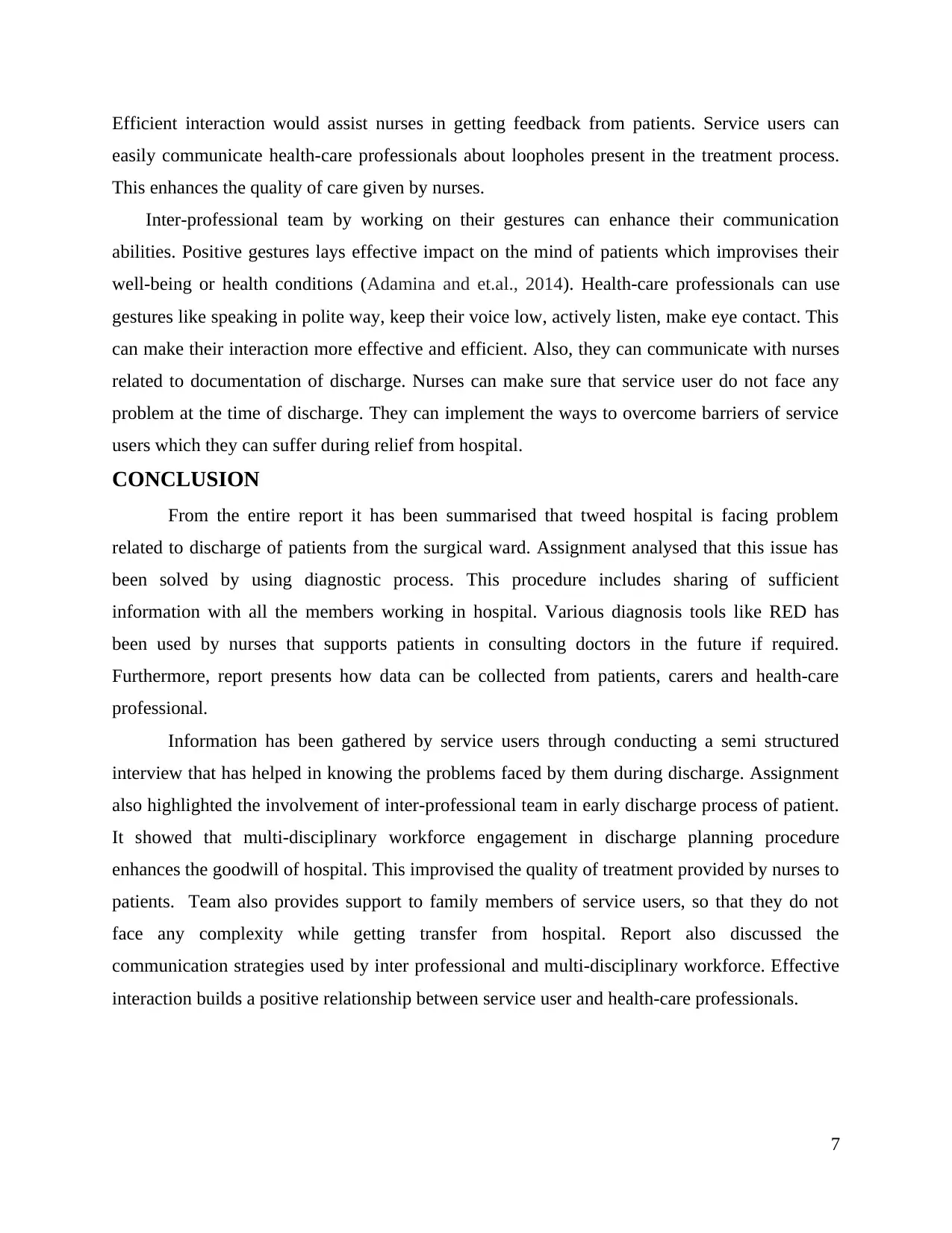
Efficient interaction would assist nurses in getting feedback from patients. Service users can
easily communicate health-care professionals about loopholes present in the treatment process.
This enhances the quality of care given by nurses.
Inter-professional team by working on their gestures can enhance their communication
abilities. Positive gestures lays effective impact on the mind of patients which improvises their
well-being or health conditions (Adamina and et.al., 2014). Health-care professionals can use
gestures like speaking in polite way, keep their voice low, actively listen, make eye contact. This
can make their interaction more effective and efficient. Also, they can communicate with nurses
related to documentation of discharge. Nurses can make sure that service user do not face any
problem at the time of discharge. They can implement the ways to overcome barriers of service
users which they can suffer during relief from hospital.
CONCLUSION
From the entire report it has been summarised that tweed hospital is facing problem
related to discharge of patients from the surgical ward. Assignment analysed that this issue has
been solved by using diagnostic process. This procedure includes sharing of sufficient
information with all the members working in hospital. Various diagnosis tools like RED has
been used by nurses that supports patients in consulting doctors in the future if required.
Furthermore, report presents how data can be collected from patients, carers and health-care
professional.
Information has been gathered by service users through conducting a semi structured
interview that has helped in knowing the problems faced by them during discharge. Assignment
also highlighted the involvement of inter-professional team in early discharge process of patient.
It showed that multi-disciplinary workforce engagement in discharge planning procedure
enhances the goodwill of hospital. This improvised the quality of treatment provided by nurses to
patients. Team also provides support to family members of service users, so that they do not
face any complexity while getting transfer from hospital. Report also discussed the
communication strategies used by inter professional and multi-disciplinary workforce. Effective
interaction builds a positive relationship between service user and health-care professionals.
7
easily communicate health-care professionals about loopholes present in the treatment process.
This enhances the quality of care given by nurses.
Inter-professional team by working on their gestures can enhance their communication
abilities. Positive gestures lays effective impact on the mind of patients which improvises their
well-being or health conditions (Adamina and et.al., 2014). Health-care professionals can use
gestures like speaking in polite way, keep their voice low, actively listen, make eye contact. This
can make their interaction more effective and efficient. Also, they can communicate with nurses
related to documentation of discharge. Nurses can make sure that service user do not face any
problem at the time of discharge. They can implement the ways to overcome barriers of service
users which they can suffer during relief from hospital.
CONCLUSION
From the entire report it has been summarised that tweed hospital is facing problem
related to discharge of patients from the surgical ward. Assignment analysed that this issue has
been solved by using diagnostic process. This procedure includes sharing of sufficient
information with all the members working in hospital. Various diagnosis tools like RED has
been used by nurses that supports patients in consulting doctors in the future if required.
Furthermore, report presents how data can be collected from patients, carers and health-care
professional.
Information has been gathered by service users through conducting a semi structured
interview that has helped in knowing the problems faced by them during discharge. Assignment
also highlighted the involvement of inter-professional team in early discharge process of patient.
It showed that multi-disciplinary workforce engagement in discharge planning procedure
enhances the goodwill of hospital. This improvised the quality of treatment provided by nurses to
patients. Team also provides support to family members of service users, so that they do not
face any complexity while getting transfer from hospital. Report also discussed the
communication strategies used by inter professional and multi-disciplinary workforce. Effective
interaction builds a positive relationship between service user and health-care professionals.
7
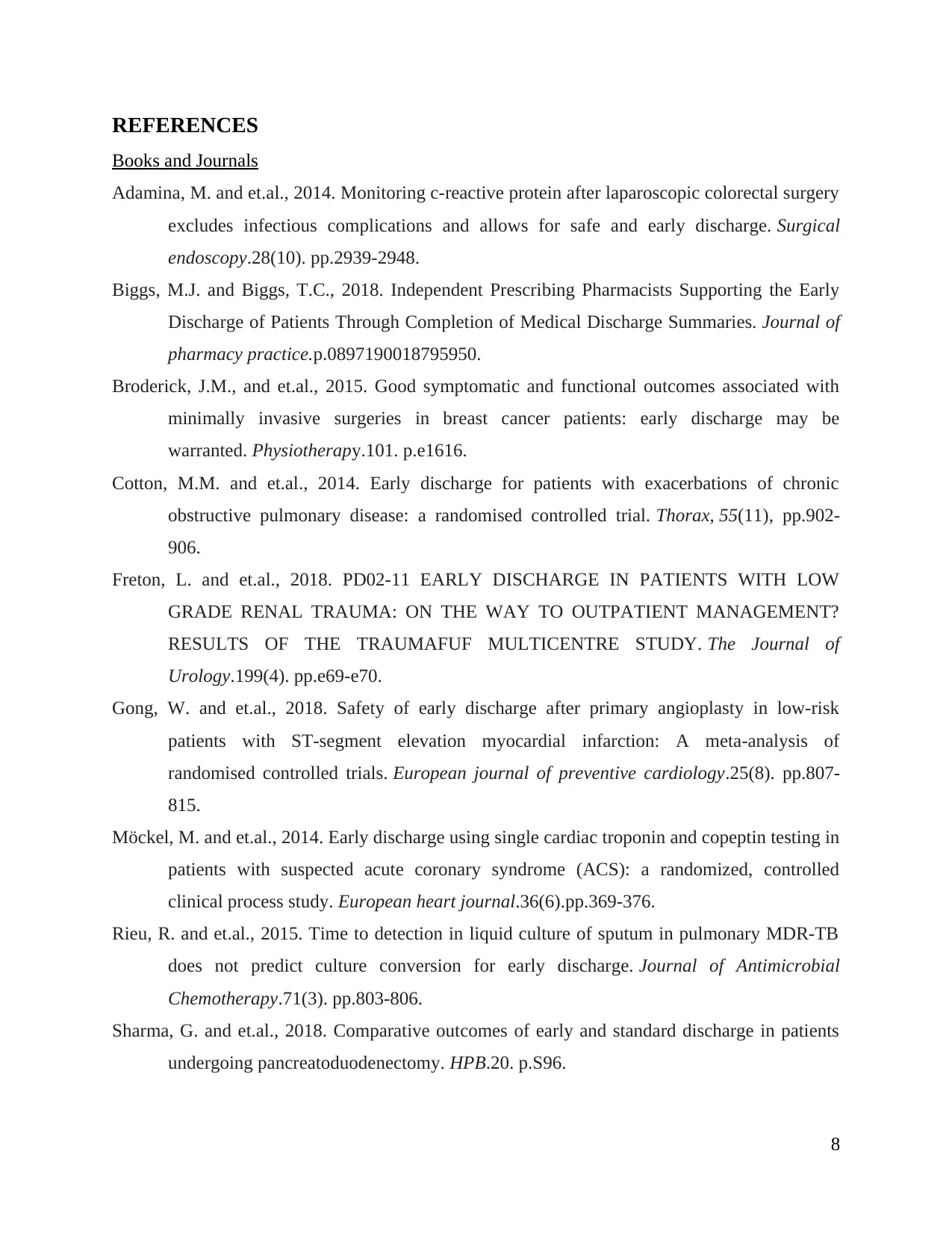
REFERENCES
Books and Journals
Adamina, M. and et.al., 2014. Monitoring c-reactive protein after laparoscopic colorectal surgery
excludes infectious complications and allows for safe and early discharge. Surgical
endoscopy.28(10). pp.2939-2948.
Biggs, M.J. and Biggs, T.C., 2018. Independent Prescribing Pharmacists Supporting the Early
Discharge of Patients Through Completion of Medical Discharge Summaries. Journal of
pharmacy practice.p.0897190018795950.
Broderick, J.M., and et.al., 2015. Good symptomatic and functional outcomes associated with
minimally invasive surgeries in breast cancer patients: early discharge may be
warranted. Physiotherapy.101. p.e1616.
Cotton, M.M. and et.al., 2014. Early discharge for patients with exacerbations of chronic
obstructive pulmonary disease: a randomised controlled trial. Thorax, 55(11), pp.902-
906.
Freton, L. and et.al., 2018. PD02-11 EARLY DISCHARGE IN PATIENTS WITH LOW
GRADE RENAL TRAUMA: ON THE WAY TO OUTPATIENT MANAGEMENT?
RESULTS OF THE TRAUMAFUF MULTICENTRE STUDY. The Journal of
Urology.199(4). pp.e69-e70.
Gong, W. and et.al., 2018. Safety of early discharge after primary angioplasty in low-risk
patients with ST-segment elevation myocardial infarction: A meta-analysis of
randomised controlled trials. European journal of preventive cardiology.25(8). pp.807-
815.
Möckel, M. and et.al., 2014. Early discharge using single cardiac troponin and copeptin testing in
patients with suspected acute coronary syndrome (ACS): a randomized, controlled
clinical process study. European heart journal.36(6).pp.369-376.
Rieu, R. and et.al., 2015. Time to detection in liquid culture of sputum in pulmonary MDR-TB
does not predict culture conversion for early discharge. Journal of Antimicrobial
Chemotherapy.71(3). pp.803-806.
Sharma, G. and et.al., 2018. Comparative outcomes of early and standard discharge in patients
undergoing pancreatoduodenectomy. HPB.20. p.S96.
8
Books and Journals
Adamina, M. and et.al., 2014. Monitoring c-reactive protein after laparoscopic colorectal surgery
excludes infectious complications and allows for safe and early discharge. Surgical
endoscopy.28(10). pp.2939-2948.
Biggs, M.J. and Biggs, T.C., 2018. Independent Prescribing Pharmacists Supporting the Early
Discharge of Patients Through Completion of Medical Discharge Summaries. Journal of
pharmacy practice.p.0897190018795950.
Broderick, J.M., and et.al., 2015. Good symptomatic and functional outcomes associated with
minimally invasive surgeries in breast cancer patients: early discharge may be
warranted. Physiotherapy.101. p.e1616.
Cotton, M.M. and et.al., 2014. Early discharge for patients with exacerbations of chronic
obstructive pulmonary disease: a randomised controlled trial. Thorax, 55(11), pp.902-
906.
Freton, L. and et.al., 2018. PD02-11 EARLY DISCHARGE IN PATIENTS WITH LOW
GRADE RENAL TRAUMA: ON THE WAY TO OUTPATIENT MANAGEMENT?
RESULTS OF THE TRAUMAFUF MULTICENTRE STUDY. The Journal of
Urology.199(4). pp.e69-e70.
Gong, W. and et.al., 2018. Safety of early discharge after primary angioplasty in low-risk
patients with ST-segment elevation myocardial infarction: A meta-analysis of
randomised controlled trials. European journal of preventive cardiology.25(8). pp.807-
815.
Möckel, M. and et.al., 2014. Early discharge using single cardiac troponin and copeptin testing in
patients with suspected acute coronary syndrome (ACS): a randomized, controlled
clinical process study. European heart journal.36(6).pp.369-376.
Rieu, R. and et.al., 2015. Time to detection in liquid culture of sputum in pulmonary MDR-TB
does not predict culture conversion for early discharge. Journal of Antimicrobial
Chemotherapy.71(3). pp.803-806.
Sharma, G. and et.al., 2018. Comparative outcomes of early and standard discharge in patients
undergoing pancreatoduodenectomy. HPB.20. p.S96.
8
Secure Best Marks with AI Grader
Need help grading? Try our AI Grader for instant feedback on your assignments.
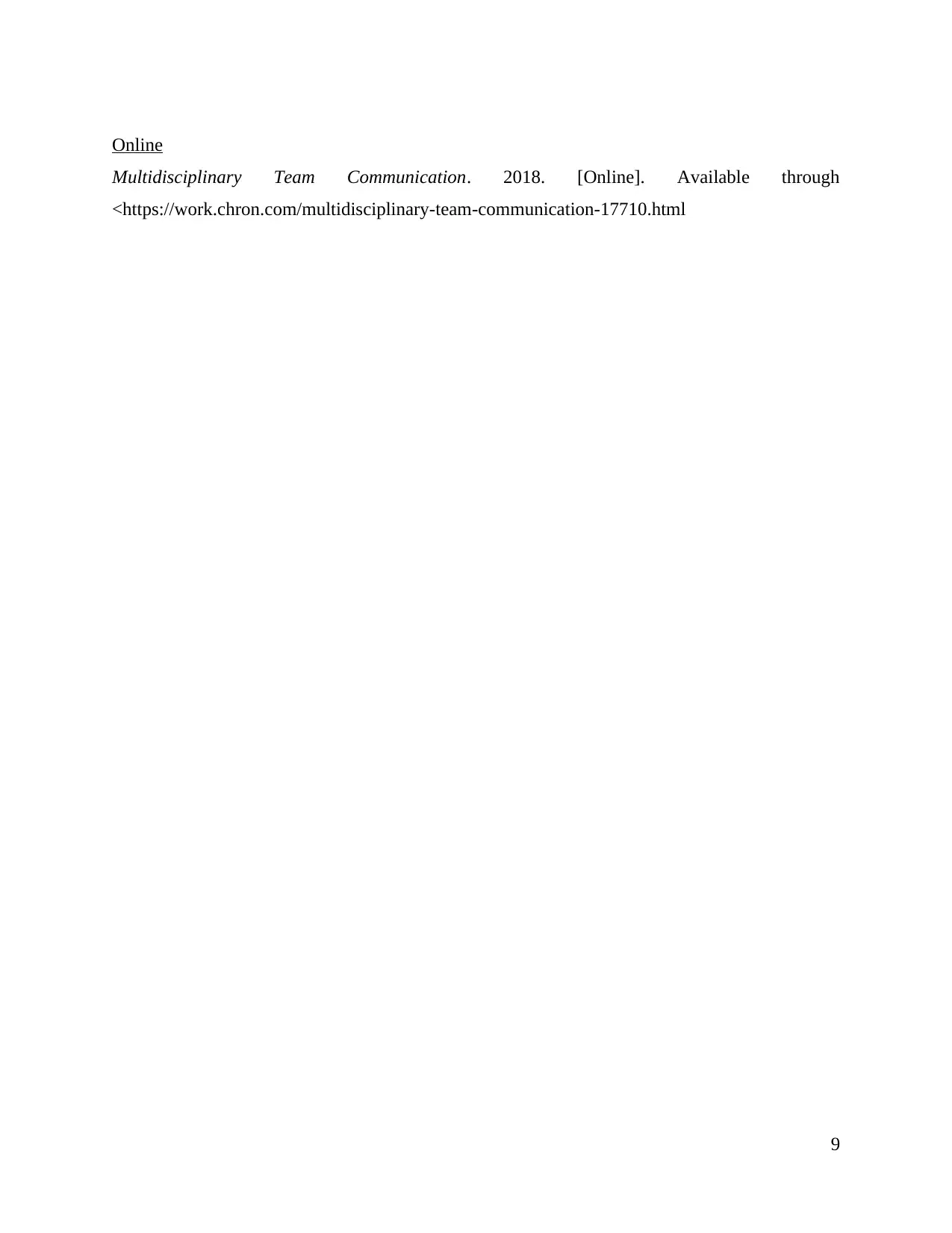
Online
Multidisciplinary Team Communication. 2018. [Online]. Available through
<https://work.chron.com/multidisciplinary-team-communication-17710.html
9
Multidisciplinary Team Communication. 2018. [Online]. Available through
<https://work.chron.com/multidisciplinary-team-communication-17710.html
9
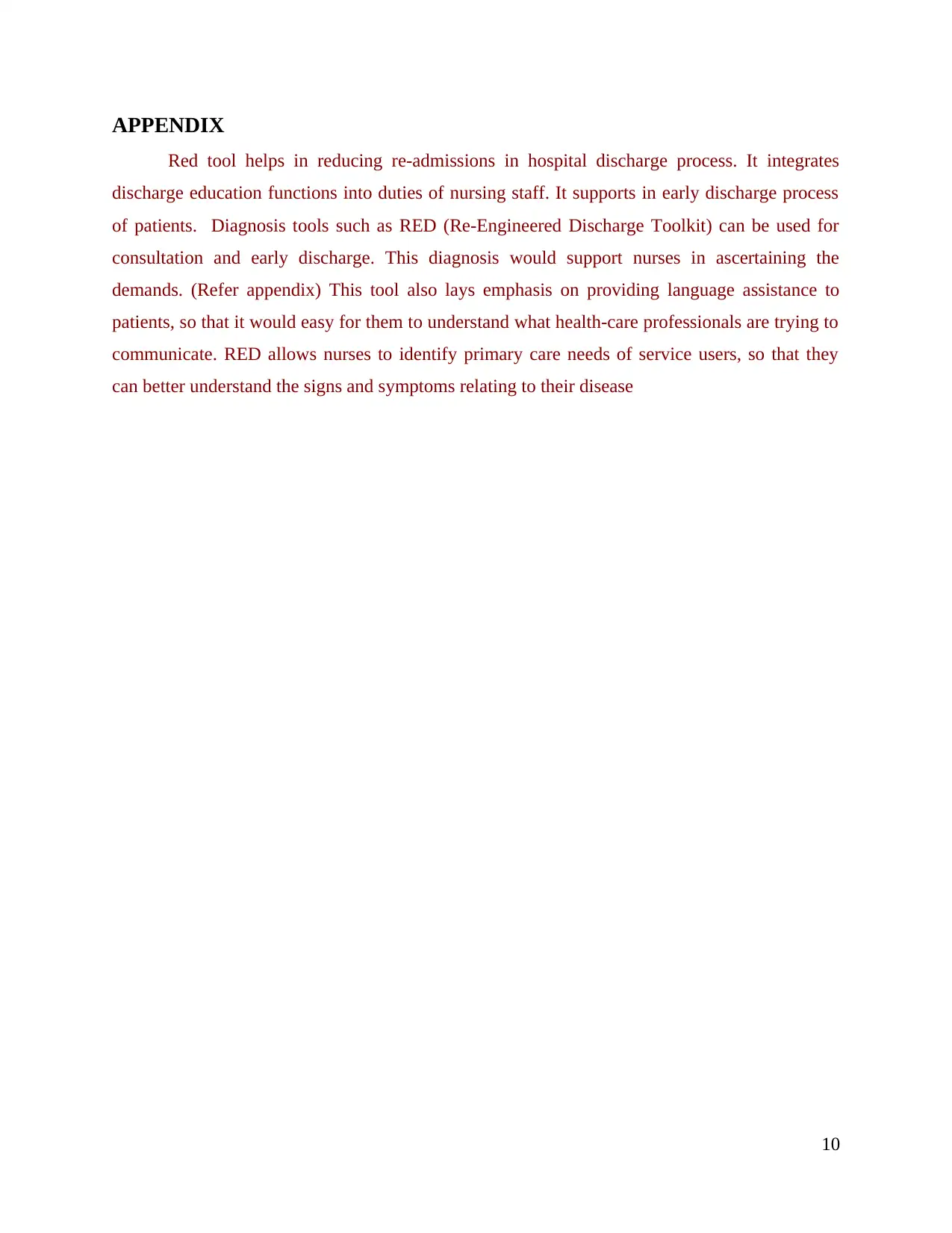
APPENDIX
Red tool helps in reducing re-admissions in hospital discharge process. It integrates
discharge education functions into duties of nursing staff. It supports in early discharge process
of patients. Diagnosis tools such as RED (Re-Engineered Discharge Toolkit) can be used for
consultation and early discharge. This diagnosis would support nurses in ascertaining the
demands. (Refer appendix) This tool also lays emphasis on providing language assistance to
patients, so that it would easy for them to understand what health-care professionals are trying to
communicate. RED allows nurses to identify primary care needs of service users, so that they
can better understand the signs and symptoms relating to their disease
10
Red tool helps in reducing re-admissions in hospital discharge process. It integrates
discharge education functions into duties of nursing staff. It supports in early discharge process
of patients. Diagnosis tools such as RED (Re-Engineered Discharge Toolkit) can be used for
consultation and early discharge. This diagnosis would support nurses in ascertaining the
demands. (Refer appendix) This tool also lays emphasis on providing language assistance to
patients, so that it would easy for them to understand what health-care professionals are trying to
communicate. RED allows nurses to identify primary care needs of service users, so that they
can better understand the signs and symptoms relating to their disease
10
1 out of 12
Related Documents
Your All-in-One AI-Powered Toolkit for Academic Success.
+13062052269
info@desklib.com
Available 24*7 on WhatsApp / Email
![[object Object]](/_next/static/media/star-bottom.7253800d.svg)
Unlock your academic potential
© 2024 | Zucol Services PVT LTD | All rights reserved.





